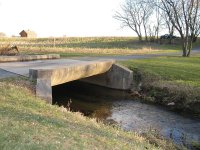Beenthere, it's the same in PA and probably a lot of other states. Our property has a small creek close to the road that we bridged. I had a PE design the bridge, and I told him we'd need to be prepared for dumptrucks, concrete trucks and hopefully never on "business" - a fire truck. He designed it to PennDot standards. It has a 14' wide bore, and the bottom of the deck is about 4' above the normal water level.
We lucked out in a couple respects. First of all, for the construction of the house, we were able to access the site through a neighbor's land. When the site plan underwent the hydro study, the engineer noted we could straighten the creek at the bridge location. This would negate the impact of adding the bridge to the stream area (bridge won't cause increased flooding). This allowed us to construct the bridge on dry land, prior to rechanneling the creek through it.
The bridge has foundations on each wall that go down about 9' to a wide footer. This puts the foundation close to 4' down below the stream bottom. Rebar ties the foundations to the footers and poured deck. It would take an A-bomb to move the thing. There's about $1,100 worth of rebar in it, and I think something like 13 yards of concrete. The deck has a mat of rebar on 4" centers that extend up into the curbs. I originally planned to build it myself, but got so busy working on the house (elec, plumbing, heat/ac, central sucuum, wiring for future sound system, etc) that it looked like I'd never get done. The house contractor volunteered to do it for around $6,000. He thought it would be a fun change of pace for his guys.
The approvals from the Department of Environmental Protection, Soil Conservation people, Township and all resulted in the project being two years in the making before we broke ground.
The bridge usually gets flooded out a couple times a year, but most of the time remains passable. Flood conditions rarely last more than a couple hours...............chim
